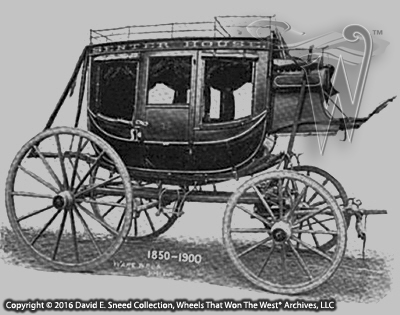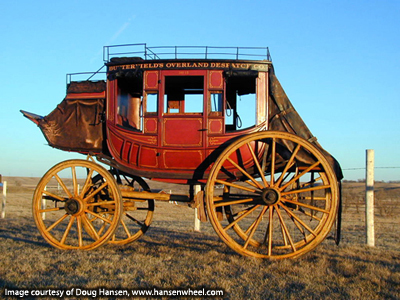Some of America's most attention-getting horse drawn vehicles are stagecoaches. So much so, that individuals, museums, and especially businesses use these pieces as significant elements in advertising and promotions. Of course, from East to West, there was an amazing variety of staging vehicles. When it comes to the more recognized Concord-style coaches, though, there are generally three basic types - Hotel, City, and Western. Each featured a triple reach design as well as a thoroughbrace suspension. The heavy Concords were also built in a range of sizes including 6, 9, and 12 passenger configurations. While thousands of stages were built across the U.S., according to well-known stagecoach historian, Ken Wheeling, less than 10% of the legendary Abbot-Downing Concords are known to have survived. A number of them are showcased in museums as well as other public and private collections. (As a side note, I just received an email from Ken letting us known that he'll be profiling the oldest known surviving coach - no. XXXI - in the October 2016 issue of the "Carriage Journal." As with all of his research, this is bound to be an interesting read.)
 |
| This rare Concord coach was ordered in 1850 by Curtis Coe for use at the Senter House in Center Harbor, NH. |
Another survivor, a city coach built well over a century and a half ago, is cared for today by the Sandwish Historical Society in Sandwich, New Hampshire. In 2017, the Society will celebrate its 100th Anniversary and, with that milestone in mind, it seemed like a good time to share a little more about this particular coach. Inside our Archives is a piece originally published in the April 1904 issue of "The Carriage Monthly." On page 162 of that trade publication is a photograph showing this same nine-passenger stagecoach. At the time, the Senter House Coach was already more than a half-century in age. The image included the follow caption...
"The accompanying cut represents a coach built by the Abbot-Downing Co., Concord, N.H., for a hotel at Center Harbor, N.H., known then as the Senter House. The order was placed on April 20, 1850, and the completed vehicle was shipped June 15th of the same year. The coach has been in continuous service since that time and the original linings and trimmings are in good condition: the same wheels are under it. The most of the work was done by Major Downing himself who, in recent years has enjoyed many a ride in it."
While the image caption above seems to indicate the coach was built by the joint Abbot-Downing firm, the vehicle was actually constructed while J. Stephens Abbot and Lewis Downing had gone separate ways. The firm of L. Downing & Sons built the coach. It is said that Major Lewis Downing, Jr. visited the coach in 1900 and claimed that, "with a few general repairs it will stand the racket for many years to come."
Like many other early resort communities, the Senter House was a large hotel using coaches for transporting guests and providing tours of the surrounding area. The photo and details from the century-plus-old story is like so many other parts of our past. It helps build and strengthen the provenance of the surviving coach while giving us a more complete picture of the era. Likewise, it's another example of why we devote so much time and energy to digging through and helping preserve early records.

Coach #84 was ordered in 1865 for the Butterfield Overland Despatch.
Looking at a slightly different-styled Concord; several years ago, I profiled a western mail stage in the Articles section of our website. The coach has an equally storied history and is currently housed in the Booth Western Art Museum in Cartersville, Georgia. Built in 1865, this Abbot-Downing survivor is number 84. It was historically conserved in 2003 and offers a rare opportunity to see the wheeled West as it was.
With several hundred period stagecoach photos already in our Archives, we continue to add rare, original images of these pieces to our collection on a regular basis. Among the more recent acquisitions is a cabinet photo documenting the retirement of the 'Good Intent' stage line after completion of the Chartiers railroad in Pennsylvania. This glimpse into yesterday will likely date to the early 1870's and prominently features a Concord with 4 horse hitch, coach lamps, and leather boots, front and rear.
More details on American stagecoaches can be found in a number of early books including "Stagecoach and Tavern Days" by Alice Morse Earle, "Six Horses" by Capt. William Banning and George Hugh Banning, and "Old Waybills" by Alvin F. Harlow. Wells Fargo even has a more recent book entitled, "Time Well Kept" that includes several high quality images of Concord coaches in their history museums. All of these and many others have a great deal to share about this part of our early transportation history. Enjoy the reads!
Please Note: As with each of our blog writings, all imagery and text is copyrighted with All Rights Reserved. The material may not be broadcast, published, rewritten, or redistributed without prior written permission from David E. Sneed, Wheels That Won The West® Archives, LLC